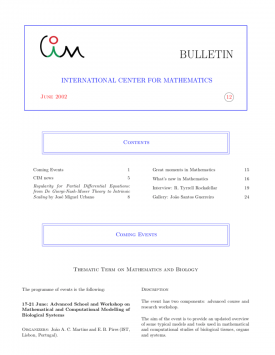Coming Events
1-4
- 17-21 June: Advanced School and Workshop on Mathematical and Computational Modelling of Biological Systems
- 24-28 June: Advanced School and Workshop on Bone Mechanics - Mathematical and Mechanical Models for Analysis and Synthesis
- 27-29 June: Workshop on Molecular Geometry Opti- mization
- 15-19 July: Summer School on Mathematical Biology
CIM News
5-7
CIM Events for 2003
The CIM Scientific Committee, in a meeting held in Coimbra on February 9, approved the CIM scientific program for 2003.
Regularity for Partial Differential Equations: from De Giorgi-Nash-Moser Theory to Intrinsic Scaling
José Miguel Urbano
8-14
In the academic year 1956-1957, John Nash had a visit- ing position at the Institute for Advanced Study (IAS) in Princeton, on a sabbatical leave from MIT, but he actually lived in New York City. The IAS at the time “was known to be about the dullest place you could find and Nash used to hang around the Courant Institute which was close to home and full of activity.
Great Moments in XXth Century Mathematics
Marcelo Viana
15
In this issue we present the answer of Prof. Marcelo Viana to the question “If you had to mention one or two great moments in XXth century mathematics which one(s) would you pick?”.
Flies, weeds and statistical mechanics
The flies are two species of fruit flies of the genus Drosophila; the weeds are two species of mustards of the genus Arabidopsis; the statistical-mechanical tech- niques are applied by a six-person Harvard-Cornell- Washington University-North Carolina State team (Bustamante, Nielsen, Sawyer, Olsen, Purugganan, Hartl) and the results are reported in the April 4 2002 Nature. The goal is to tease out the pressure of natural selection on individual genes; they use a sophisticated “analytical method that borrows information from all the genes to make inferences about the magnitude of selection for any individual gene.” The method, a “hierarchical bayesian analysis”, leads to analytically intractable calculations. The authors handle them with Monte Carlo Markov Chain computation scheme bor- rowed from thermodynamics. The title of the work is ”The cost of inbreeding in Arabidopsis”.
R. Tyrrell Rockafellar
Luís Nunes Vicente
19-23
There are obvious reasons for concern about the current excessive scientific specialization and about the uncontrolled breadth of research publication. Do you see a need for increasing coordination of events and publica- tions in the mathematical community (in particular in the optimization community) as a way to improve quality?
Outline of a biography of Professor João Guerreiro
Luis Saraiva
24-27
We start with a foreword, to put into perspective the background from which this outline of a biography of Professor Guerreiro takes shape. Although this text is based on objective and historical data, it is also a deeply personal and subjective testimony. It is intended to go beyond an account of Professor Guerreiro’s math- ematical and teaching career: we want to give an accurate account of the extraordinary impact this mathematician and professor had on successive generations of people who had the privilege of talking and working with him.
